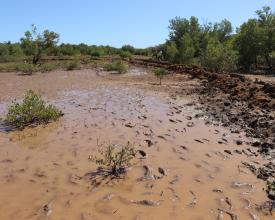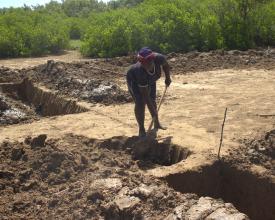
Restauración comunitaria y asistida de manglares naturales

Los manglares son humedales costeros de valor único que forman la zona de transición natural entre la tierra y el mar. Preservan la biodiversidad, mitigan el cambio climático y mantienen los medios de subsistencia. Sin embargo, están degradados en todo el mundo y son, por tanto, una prioridad para la restauración del ecosistema.
Madagascar ocupa el cuarto lugar de África en extensión de manglares, con varias especies que proporcionan bienes y servicios ecosistémicos críticos a las comunidades costeras y sustentan una rica biodiversidad. Por desgracia, los manglares de Madagascar se están degradando rápidamente y, en algunas zonas, se están deforestando por completo.
El proyecto mundial Forests4Future (F4F), puesto en marcha por la Deutsche Gesellschaft für Internationale Zusammenarbeit (GIZ), utiliza un método de bajo coste de Restauración Natural Asistida y Basada en la Comunidad de los Manglares en la región de Diana (Madagascar) para restaurar los ecosistemas de manglares degradados. Esta técnica permite el establecimiento de corrientes de marea y plántulas (propágulos) en ecosistemas de manglares más interiores y degradados utilizando canales de agua excavados.
Contexto
Défis à relever
Las principales causas de la degradación de los manglares son la creciente presión de la población costera local, la conversión a la agricultura a pequeña escala, la sobreexplotación de los productos forestales (madera, leña, etc.) y la erosión y sedimentación debidas a la agricultura y la deforestación río arriba.
Uno de los principales retos de la restauración son las malas condiciones hidrológicas de muchos ecosistemas de manglares degradados, que dificultan considerablemente el crecimiento de los propágulos jóvenes. Este es especialmente el caso de los ecosistemas de manglares más interiores y degradados. En general, estas zonas tienen una conectividad limitada o reducida con el mar, lo que impide que las corrientes de marea lleguen y permitan el reclutamiento de las semillas.
Con la construcción de canales de agua mareal, se mejoran las condiciones hidrológicas y del suelo, así como el transporte, asentamiento y crecimiento de las plántulas.
Los ecosistemas de manglares restaurados permiten el regreso de muchas especies animales de las que pueden volver a beneficiarse las comunidades costeras, los pescadores, los agricultores y otros usuarios de los recursos.
Ubicación
Procesar
Resumen del proceso
Los cuatro componentes básicos propuestos son una secuencia de tareas y actividades que se repiten con frecuencia (ciclo de trabajo) para garantizar la sostenibilidad del método de restauración. Además, están interconectados entre sí. Por ejemplo, si durante el Bloque de Construcción 3 (Observación y seguimiento de los manglares restaurados) se observan daños en el sistema de canales, el Bloque de Construcción 2 (Reunión preparatoria, movilización de la comunidad e implementación) volverá a tener efecto, lo que significa que toda la comunidad (o parte de ella) se movilizará para reparar los daños. La comunidad debe identificar la causa de los daños para poder actuar en consecuencia y readaptar el método (si es necesario).
Este enfoque holístico permite aprender de los errores y adaptarse a cualquier condición cambiante (proceso de aprendizaje).
Bloques de construcción
Identificación y validación comunitaria del lugar de restauración
La identificación y validación del lugar de restauración se llevó a cabo conjuntamente con la comunidad local para promover su adhesión al proceso. También se incluyó al servicio forestal regional y a técnicos de la ONG Conservación Internacional (CI) para garantizar la viabilidad técnica del lugar propuesto.
Los ancianos de la comunidad local, que conocen el contexto histórico, medioambiental y topográfico, suelen ser muy buenos asesores para la elección del lugar de restauración. Pueden indicar dónde se pueden encontrar zonas de manglares degradadas (tierra adentro) con algunas plantas remanentes (el lugar de restauración debe haber sido un ecosistema de manglares en el pasado). Suelen ser lugares adecuados para la reforestación/restauración.
Factores facilitadores
La comunidad debería ser la entidad líder del proceso, ya que conoce muy bien el contexto local y es la beneficiaria. Deberían tener derecho a gestionar los manglares mediante un contrato formal de gestión, porque la propiedad confiere la responsabilidad y el compromiso de gestionar el lugar de forma sostenible.
Desde un punto de vista técnico, los siguientes criterios son cruciales:
- Zona inundable existente durante las mareas bajas y canales presentes;
- Tipo de suelo (fangoso o arenoso-fangoso) y pH;
- La salinidad del agua debe ser salobre.
Lección aprendida
El conocimiento y la participación locales son cruciales para garantizar la sostenibilidad de los lugares de restauración. En nuestro caso, la identificación del lugar de restauración sin el conocimiento de los ancianos locales habría sido mucho más difícil y habría llevado más tiempo, ya que no estamos familiarizados con la zona y se dispone de poca información sobre algunas zonas de Madagascar.
Reunión preparatoria, movilización de la comunidad y ejecución
Previamente se organizaron reuniones comunitarias en la aldea vecina para concienciar sobre la importancia de la restauración de los manglares. Durante estas reuniones, se informó a la comunidad de los principios del método de restauración y de los pasos a seguir. Dado que la restauración de los manglares no requiere conocimientos técnicos particulares (know-how), se dirigió a toda la comunidad (mujeres, hombres y jóvenes) y se movilizó para llevar a cabo nuevas acciones. Además, también se implicó a las autoridades locales, los servicios técnicos estatales y las autoridades administrativas, para que el método pudiera reproducirse fácilmente en otros lugares.
Factores facilitadores
Los debates en profundidad con la comunidad local y los expertos técnicos fueron cruciales para un diseño adecuado del sistema de canales en esta zona. El canal se excavó de acuerdo con el contexto topográfico local, es decir, profundidad del canal, ángulo del emplazamiento del canal, longitud, punto de partida, etc.
(1) Se movilizó a 50 miembros de la comunidad local para excavar el canal. (2) Se identificó una zona de 40 ha de manglares degradados. (3) Se excavó un sistema de canales con una longitud total de 2.200 m para promover la recolonización natural en las zonas degradadas.
Lección aprendida
Para motivar a los distintos grupos comunitarios (mujeres, hombres y jóvenes) para los trabajos de restauración, hay que tener en cuenta sus intereses. Además, sus beneficios futuros (bienes y servicios del ecosistema) deben discutirse de forma comprensible y participativa. Esto incluye, sobre todo, la seguridad alimentaria y la generación de ingresos.
Observación y seguimiento de los manglares restaurados
En este bloque se contemplan cuatro tipos de acciones:
- Misiones de observación por parte de la comunidad local que consistirán en evaluar si se produce el reclutamiento de plántulas (propágulos), definir el nivel de crecimiento (altura) y evaluar los posibles daños causados por los rebaños circundantes (especialmente por los rebaños de cebúes) o los riesgos climáticos;
- Misión de seguimiento del estado de los canales de agua para comprobar si las riberas siguen siendo estables y es posible la descarga (flujo), especialmente durante las mareas altas (02 meses después de la plantación);
- Primera estimación del nivel de éxito, por ejemplo, superficie aproximada de asentamiento de plántulas (03 meses después de la restauración).
- Seguimiento a largo plazo (biomasa y biodiversidad) mediante drones e imágenes por satélite; este paso se llevará a cabo conjuntamente con la GIZ, el Ministerio malgache de Medio Ambiente y Desarrollo Sostenible (MEDD) y la comunidad local (a partir de 03 meses después de la restauración).
Factores facilitadores
Para proteger las jóvenes plántulas de la migración de cebúes y la tala ilegal (la madera de los manglares tiene un gran valor) y otros peligros en los lugares reforestados, dos guardas de la comunidad local trabajan de forma rotatoria durante los primeros 4 meses. Se compró una lancha motora para que los guardas pudieran acceder más fácilmente a los manglares. En general, es muy importante que la comunidad sea la entidad líder en el proceso de vigilancia para garantizar la sostenibilidad del método.
Lección aprendida
Es necesario implantar un buen sistema de vigilancia a largo plazo para proteger con éxito los nuevos plantones de cualquier peligro. La tala ilegal y los daños causados por los rebaños de cebúes son muy frecuentes en nuestra zona.
Evaluación de los primeros resultados por la comunidad local
Al cabo de tres meses, los trabajadores de la construcción de la comunidad fueron al campo para ver si los resultados eran visibles y evaluarlos. Los primeros resultados fueron claramente observables. Se han producido asentamientos y crecimientos de plántulas en las proximidades de las salidas de los canales, lo que indica la funcionalidad de los canales de agua excavados y de todo el método de restauración. Las condiciones hidrológicas también mejoraron claramente; la superficie dura y seca del suelo de las zonas degradadas cambió visiblemente a una capa más blanda y fangosa, lo que permitió el regreso de muchas especies de animales e insectos. Por ejemplo, al cabo de tres meses se podían encontrar muchos montoncitos de arena excavados por cangrejos (por ejemplo, cangrejos de fango - Scylla serrata).
Factores facilitadores
Para garantizar el éxito de la restauración, es crucial contar con un sistema de protección comunitario, de modo que no puedan entrar rebaños de cebúes y dañar el lugar de restauración ni se produzcan talas ilegales.
Lección aprendida
Es crucial vigilar regularmente la funcionalidad del sistema de canales, especialmente de las salidas de los mismos, para que los propágulos puedan llegar a los lugares de restauración. Los canales colapsados hacen imposible el transporte de propágulos.
La comunidad local, con su motivación, es el éxito del seguimiento.
Impactos
Aumento de la biodiversidad, protección del litoral (frente a la erosión), mejora de las condiciones de vida y desarrollo de la cadena de valor. Además, el método refuerza la cohesión y la colaboración comunitarias.
En nuestra zona (cuenca de Irodo) hay un total de 6 especies de manglares: Rhizophora mucronata, Bruguiera gymnorrhiza, Heritiera littoralis, Ceriops tagal, Avicennia officinalis y Sonneratia alba. Por ejemplo, algunas especies tienen flores que pueden utilizarse para la producción de miel, mientras que otras son aptas para la extracción de seda. La transformación y la venta de estos productos tienen un impacto socioeconómico a largo plazo en la comunidad local (mejora de las condiciones de vida y desarrollo de la cadena de valor).
Beneficiarios
Comunidades costeras (incluidas mujeres, hombres y jóvenes), pescadores, agricultores y otros usuarios de los recursos.

















